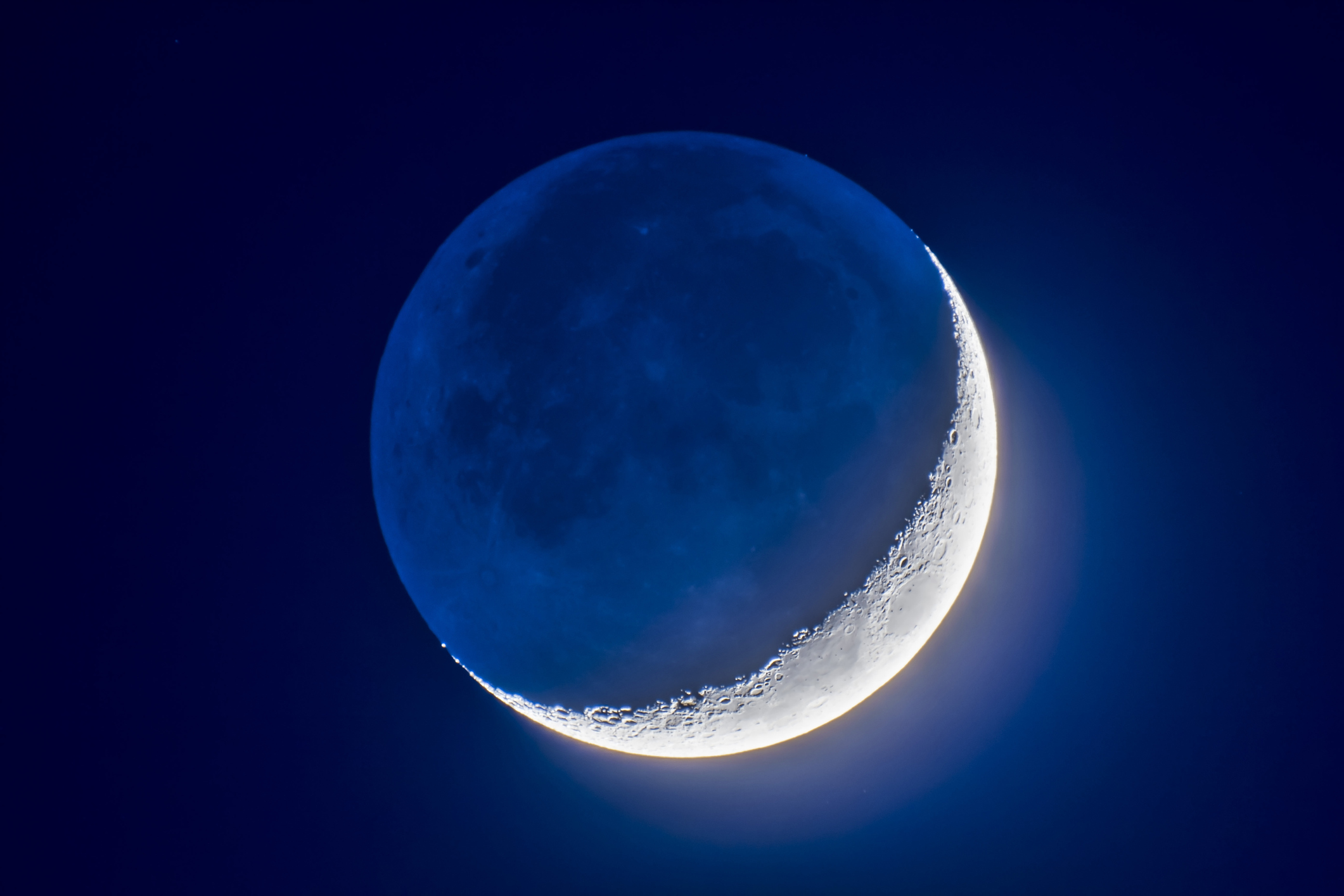See the crescent moon and Jupiter meet up in the night sky March 13

If the weather is clear on Wednesday evening (March 13), check out the western sky around mid-twilight — about an hour after sunset. There, about one-third of the way up from the horizon to the overhead point, you'll see an eye-catching sight: A lovely, thin crescent moon, 18 percent illuminated by sunlight — and situated about 3 degrees to the left of this slender lunar sliver will be a brilliant silvery white "star."
This isn't a star, but the planet identified with the supreme sky-god, Jupiter. To judge how far apart they will appear in the sky, recall that your clenched fist, correctly held, will measure about 10 degrees. So, you can use your fist to make a reasonable estimate of degrees either horizontally or vertically. In this case, both moon and planet should appear separated by about one-third of the width of a fist.
Even though they won't appear particularly close together, both the moon and Jupiter will likely attract the attention of even those who aren't consciously looking up at the sky. During the early and mid-evening hours, they will appear to descend down the western sky, finally disappearing beyond the western horizon soon after 10 p.m. local daylight time.
Related: Night sky, March 2024: What you can see tonight
Read more: Full moon calendar 2024: When to see the next full moon
Look for Earthshine

Want to see the moon or Jupiter up close? We recommend the Celestron Astro Fi 102 as the top pick in our best beginner's telescope guide.
Binoculars will greatly enhance the view, not only of the moon, but also of the phenomenon known as Earthshine; the waxing crescent moon appearing as a thin arc of yellowish-white light enclosing a ghostly bluish-gray ball.
Actually, for at least several nights, up to nearly a week after a new moon, sunlight reflected from Earth illuminates the night side of the moon, making its whole disk visible. Here is one of nature's beautiful sights and fits the old saying, "the old moon in the new moon's arms."
Jupiter is still the brightest star-like object in the evening and the first to come out each night at dusk. It still outshines the brightest true stars; in fact, it's nearly twice as bright as the brightest of all the stars, Sirius, which in early evening sparkles about one-third of the way up in the southern part of the sky.
Breaking space news, the latest updates on rocket launches, skywatching events and more!
Note how Jupiter shines with serene steadiness while Sirius, twinkles vigorously, as if struggling to match Jupiter's glory.
Exits the evening sky in April
But during March Jupiter will slip farther down toward the glow of evening twilight in the west-northwest. And by the end of the third week of April it will be setting right around the time evening twilight ends. This month Jupiter is falling far behind Earth in the never-ending planetary race around the sun and it continues to move slowly eastward among the stars.
Currently it is located within the boundaries of Aries the Ram, but on April 28, it will cross over into Taurus the Bull. Shortly after that, Jupiter will disappear into the sunset fires and will not reappear again until the second week of June, when it will be visible low in the east-northeast sky just prior to sunrise.
If you're hoping to catch a look at Jupiter near the crescent moon, our guides to the best telescopes and best binoculars are a great place to start. If you're looking to snap photos of the night sky in general, check out our guide on how to photograph the planets, as well as our best cameras for astrophotography and best lenses for astrophotography.
Editor's Note: If you snap an image of the moon near Jupiter and would like to share it with Space.com's readers, send your photo(s), comments, and your name and location to spacephotos@space.com.
Joe Rao serves as an instructor and guest lecturer at New York's Hayden Planetarium. He writes about astronomy for Natural History magazine, the Farmers' Almanac and other publications.

Joe Rao is Space.com's skywatching columnist, as well as a veteran meteorologist and eclipse chaser who also serves as an instructor and guest lecturer at New York's Hayden Planetarium. He writes about astronomy for Natural History magazine, Sky & Telescope and other publications. Joe is an 8-time Emmy-nominated meteorologist who served the Putnam Valley region of New York for over 21 years. You can find him on Twitter and YouTube tracking lunar and solar eclipses, meteor showers and more. To find out Joe's latest project, visit him on Twitter.

